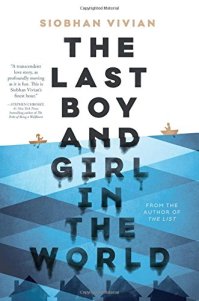 Why do you write? What drives you to create the stories you do? Last month, the National Council of Teachers of English held a day of celebration of writing in which they asked people to share why they write in an effort to show students that writing isn’t just for school assignments. From WhyIWrite.us:
Why do you write? What drives you to create the stories you do? Last month, the National Council of Teachers of English held a day of celebration of writing in which they asked people to share why they write in an effort to show students that writing isn’t just for school assignments. From WhyIWrite.us:
“It’s part of how you work, how you learn, how you remember, and how you communicate. It gives voice to who you are and enables you to give voice to the things that matter to you.”
Today we are appreciative for author Siobhan Vivian for sharing with us in this guest post why she writes the stories she does and how her background in publishing influences her as a writer.
Her latest book, The Last Boy and Girl in the World, offers a first person view of a teen girl navigating a new relationship while her town goes through a disaster that threatens to change everything for her. Like Vivian’s previous books, it is an emotional story with a strong girl at the heart of it. As she shares in the post below, this is not unintentional.
—–
Whenever I begin writing a new novel, my compass is always set to truth. Or, to be specific, my desire is always to write real stories about real girls. My career in publishing, however, began on the complete opposite end of that spectrum.
Before I became an author, I worked as an editor at a very well known book packager of commercial teen fiction. I was on a relatively low rung on the ladder, and my list was primarily composed of books written by Not Real People—fake names that the packager could control, ghost-written by multiple freelance authors-for-hire.
The books I edited all looked the same—covers featuring the tanned midsections of girls in bikinis, a touch of sun glare on the camera lens. And they were mostly about the same thing—rich girls in romantic peril. These books were escapist fun, one-offs, with fancy brand names peppered into the prose.
I don’t mean to sound dismissive. I completely get the power of aspirational elements in teen fiction. It’s fun for girls to picture themselves as these characters and escape their real lives for a little while. What teenager wouldn’t want to be rich, beautiful, and desired?
The answer, it turns out, is most. These books were incredibly successful in the marketplace. They were gobbled up like Skittles…little bright bursts of sugar.
But I still had a hard time working on them, mainly because they didn’t reflect my world as a teen. I didn’t grow up rich, nor did I know anyone who was. I had never been to Ibiza. These books didn’t even reflect my world as an adult; the characters regularly toted their schoolbooks in handbags that cost more than my annual salary.
Now, while I edited books by day, I also attended an MFA program at night, working on books that felt real to me. Stories about myself, girls I knew in high school. Some of my professors sniffed their noses at commercial fiction, dismissing all of it out of hand. There were times when I kept my day job hidden, for fear someone might think less of my writing because of it.
The manuscripts I worked on during my MFA well well-received by faculty, I couldn’t ignore the nagging feeling that if I pitched my works-in-progress at my job, I’d be told that my ideas felt too small, that they didn’t have enough of a hook, or that the stakes weren’t high enough. This paranoia was amplified by actually existing in the business of publishing. Unlike my fellow classmates, I had access a BookScan account.
It got to a point where I felt like each camp was holding a hand behind my back. I couldn’t write anything.
But then I realized, the awareness of both sides of the publishing spectrum—artist and editor—didn’t have to be a handicap. It could be an asset. Could I create something that would satisfy both camps?
It was an interesting challenge. And one that motivates my writing to this day.
—
From the Publisher
About the Author: Siobhan Vivian is the author of the young adult novel The List, as well as Not That Kind of Girl, Same Difference, and A Little Friendly Advice, and the Burn for Burn trilogy, co-written with Jenny Han. A former editor for Alloy Entertainment, she received her MFA in creative writing at the New School. She teaches creative writing at the University of Pittsburgh. Visit her at SiobhanVivian.com.
More Books by Siobhan Vivian:
Burn for Burn with Jenny Han
Fire with Fire with Jenny Han
Ashes to Ashes with Jenny Han






